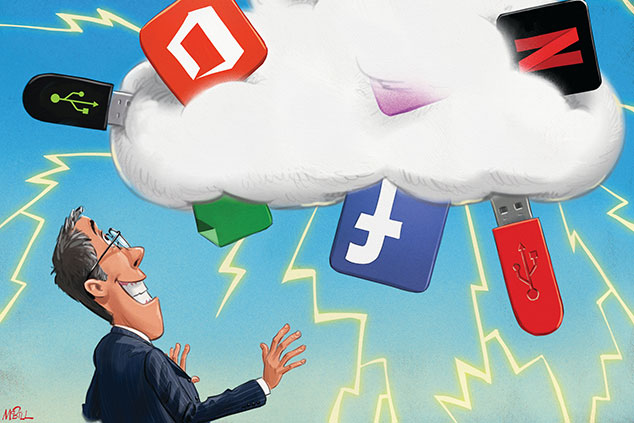Internet 2.0: how to cash in on the shift to cloud computing
Cloud computing technology helps companies manage their IT more efficiently and will also ensure that the world wide web and key innovations such as artificial intelligence fulfil their potential, says Stephen Connolly.

The concept of cloud computing has emerged from a realisation that there are better ways for the world to manage its information technology. We examine the idea in detail in the box below, but it broadly refers to storing or managing data and delivering IT services on the internet, rather than in-house. It is revolutionising computing and business, and is here to stay. Building cloud platforms and servicing users is big, lucrative work. Tech giant Amazon now makes more money pushing its cloud offering than flogging goods online.
Migrating to the cloud
And yet it's still early days. Most businesses have just begun the journey to getting on the cloud, according to consultants McKinsey & Co, and there's a long way to go. Furthermore, plenty have tired, bespoke and cobbled-together IT systems that are well past their sell-by dates. It is so much easier, not to mention more secure, to opt for an up-to-date set-up that someone else organises for you on a cloud platform.
This means that cloud computing is no short-term flash in the pan. It's a sector set to progress over many years, driven by rising numbers of users and more complex work to help platforms' corporate customers innovate and reinvent themselves in a fast-paced digital world. Long-term forecasts are wide open, but they range between annual growth of 15% and 30%. Even if expansion came in no higher than the most conservative estimates, committed investors are unlikely to be disappointed.
MoneyWeek
Subscribe to MoneyWeek today and get your first six magazine issues absolutely FREE

Sign up to Money Morning
Don't miss the latest investment and personal finances news, market analysis, plus money-saving tips with our free twice-daily newsletter
Don't miss the latest investment and personal finances news, market analysis, plus money-saving tips with our free twice-daily newsletter
Of course, merely having cloud platforms and being able to migrate businesses and revamp their IT can't in itself explain the confident belief that many large and small businesses the world over will make and pay for the switch from their current systems. IT can be an early victim of uncertainty and difficult trading conditions, with companies happy to "make do" and bump spending plans into the next financial year and beyond. The current global economic backdrop is volatile and the trade dispute between the US and China is compounding worries.
This could have an impact, but there are compelling practical reasons for cloud migration that are likely to improve the bottom line for businesses. It's arguable that a weaker economic environment only makes switching to the cloud more of an imperative. Leading cloud provider Amazon showed recently that on average its customers spend $109,718 a year running a standard web application in-house; this drops 76% to $26,786 using Amazon's cloud. For data processing, the average cost is $927,064 in-house, which halves to $455,593 on the cloud. And an in-house core business application (software used to perform key tasks for the company) sets the average client back $261,353, whereas on Amazon's cloud it's only $111,136.
Before looking into the practical benefits in detail, however, it's first worth considering the bigger picture. Operational advantages are important, but in the case of the cloud when weighing up its significance for the future of computing and business, the whole represents more than the sum of the parts.
Joined-up computing comes of age
The joined-up computing called for by Apple co-founder Steve Jobs in 1997 is here now, increasingly permeating everyday life, as anyone with a smartphone, for example, knows. For Jobs, "carrying around these non-connected computers with tons of data and state in them is byzantine". Others have made similar calls before and since. A large part of the change from then to now is down to the cloud, which allows everything to be connected seamlessly. Widely used companies and services use the cloud to provide their products and interact with customers, including Netflix, Skype, WhatsApp, Microsoft Office, Adobe, Google Docs, Facebook and LinkedIn. It's significant enough that there are people today who use the term "cloud" interchangeably with "internet", while others talk only of the former, almost relegating the internet to obscurity.
Either way, plenty of people see the cloud as a kind of "Internet 2.0". The internet is the infrastructure, while the cloud is the service. It's like electricity, with the internet being the cables and pylons, and the cloud the power that travels across the network into homes and businesses.
The disappearing internet
This line of thinking is crucial to appreciating how fundamental the cloud is in the evolution of computing and its place in the world. It was Google's former boss Eric Schmidt who said: "The internet will disappear. There will be so many IP addresses, so many devices, sensors, things that you are wearing, things that you are interacting with, that you won't even sense it. It will be part of your presence all the time". Schmidt's view chimes with that of the highly-respected CEO of Microsoft, Satya Nadella. For him, computing and technology is becoming embedded everywhere, to the extent that it is shaping people's lives, whether at work, at home, or while socialising. As he puts it: "It's amazing to think of a world as a computer".
It's impossible not to sense the encroachment of computing into daily life, whether it's backing up every photo taken, launching a film on demand, or finding the fastest route from A to B on a satnav. This is simply the surface. Deeper down, business applications interact with customers and make decisions on consumer loans at banks, assess live traffic conditions and change travel plans, try to sell products based on past spending, and play an increasing part in health diagnostics. With advances in technology which are happening on an almost daily basis and the passing of generations, this will increasingly permeate our lives.
What the likes of Schmidt and Nadella are alluding to, and what is being borne out each day by our interactions with devices such as mobiles, tablets and even watches, is that the ongoing path to cloud adoption is fulfilling an early promise of the internet: an always present, always knowing technology at your service. There is a tech industry dream of homes with everything from the plumbing to the fridge bristling with sensors that build data about how you live, augmented by your car routes and travel passes, your daily itineraries and interactions, and your spending and entertainment habits. Bits of this are already in place. Whether well-established multinationals or small-scale start-ups, businesses around the world cannot afford to ignore this.
Great leap forward
This is why the cloud is big business. It is capable of joining up more and more interactions between people and their devices, accommodating the exploding amounts of associated raw data and providing the huge computing power needed to process it meaningfully. Taken as a whole, the cloud platform is central to realising the potential of key digital themes such as big data, artificial intelligence, machine learning and algorithmic processing.
This would be a challenge for any in-house IT department. And switching to the cloud is both profitable and practical. Shift to the cloud and companies no longer have to pay upfront for software and installing other specific systems. Software doesn't date the cloud will automatically render the latest version. The costs of staff to maintain systems disappears, and the downtime from a fully developed professional cloud platform is likely to be much lower than an in-house system. Once a firm is on the cloud, its users, whether employees or customers, can access data from anywhere on any device, making everyone fully connected all the time.
Data on a professional platform is also likely to be more secure than on an in-house managed system; security is a reputational and financial risk every business wants to neutralise. And whereas a company storing its data locally will lose access to it if there's a fire or a flood, it's always available on the cloud. Above all, it's about scale. Data storage is generally pay-as-you-go. Organisations don't always need constant storage capacity and so a cloud platform gives them the flexibility to add data as and when they need it to meet the development of their businesses.
These arguments are clearly compelling. Nearly 60% of Amazon's operating profits now come from cloud activity. In fact, it's the number-one player in the sector, with some 40% share of the market. For every dollar it takes in from its more familiar e-commerce business, its operating profit is about 2.5 cents. But when it comes to cloud-related sales, it makes over 28 cents. Its cloud business is growing most rapidly too. E-commerce sales rose by 28% in 2018, but cloud sales by 47%.
Microsoft: a charging elephant
Microsoft, the second-biggest operator, has been catching up. Its latest results beat all expectations, with cloud activities the strong driver. Profits were up 22% year-on-year and the company has advised that it expects to lift sales and operating profits by double-digit percentages this year too. In its final quarter of trading, Microsoft's earnings were up a huge 49%. Remember this is a $1trn-plus business elephants are not supposed to move this quickly.
With strong financial results, it's not surprising that analysts have punchy expectations for growth in the overall cloud-computing sector. Gartner expects cloud-services revenue to reach $214bn this year, up 17.5% from the $182bn in 2018: "[This] is only the beginning. Through to 2022, we project the market size and growth of the cloud-services industry at nearly three times the growth of overall IT services".
The big players of the future
Cloud computing will grow and become increasingly relevant to every business and individual. It frees businesses to innovate with regard to how they make money and interact with their customers. There will be new companies with fresh ideas that can flourish using the power of the cloud to build scale without the constraint of capital expenditure.
Of course, backing these individual companies could prove profitable. But the cloud operators will have a finger in every pie and benefit from the collective move to embed computer technology everywhere. Creating cloud capacity isn't cheap building lots of data-storage centres is costly and there are few players, with the top two well ahead of the rest. As the cloud becomes more core, the small number of operators will become increasingly powerful no bad place for shareholders to be.
What to buy now
Microsoft (Nasdaq: MSFT) is a class act that has been transformed under the leadership of CEO Satya Nadella. Recent results were strong and broad-based across the group, and the outlook is upbeat. The cloud is a key focus and in this context the company should be able to exploit client relationships built on its long-standing Office and Windows products, which still drive significant revenues. These, together with Skype, LinkedIn, Surface devices and Xbox gaming consoles, make Microsoft a strong cash-flow generator. It's a very attractive long-term bet on 24 times next year's earnings.
Meanwhile, shares in Amazon (Nasdaq: AMZN) peaked earlier this year at just over $2,000, but have since tumbled to $1,750 after earnings in July missed expectations. Growth, however, remains strong, with economies of scale expanding margins. Amazon is a tricky one to recommend as the valuation is always well above market averages, but it has continued to defy sceptics and deliver. It is the number-one cloud player and has a clear market lead. Warren Buffett has invested this year. The $1bn stake bought by his Berkshire Hathaway investment vehicle isn't huge, but nonetheless represents a vote of confidence in the group.
An alternative play on the cloud is International Business Machines (NYSE: IBM). Its shares trade significantly below market averages and offer a huge 4.8% dividend, which is expected to grow. IBM has been around for a long time, but over recent years lost direction, leaving it with low-growth legacy businesses that it is now shedding. It has bolstered its cloud capabilities through the $33bn acquisition of Red Hat, a leader in helping businesses navigate the new opportunities, and it could be transformative. If it comes off, the upside should be rewarding, while that strong dividend provides good support.
Two firms that have successfully exploited the cloud to deliver exceptional growth and hence worth a good look, are Adobe (Nasdaq: ADBE) and Intuit (Nasdaq: INTU). The former offers a suite of creative applications for design, publishing, photography and video. The latter produces accounting and tax software for small businesses and individuals. Both have great records and strong prospects. They exemplify the ability to offer applications on the cloud and turn these into recurring monthly subscription fees, upending the traditional business model of one-off sales of software products.
For those who like funds, there's an American exchange-traded fund on the Nasdaq focused on the cloud industry and approved by HMRC in the UK for tax purposes. First Trust Cloud Computing ETF (Nasdaq: SKYY) is valued at $2.2bn.
First Trust has delivered 15% a year for investors after costs (0.6% a year) and tracks a basket of 62 cloud-related companies with a minimum market size of $500m. Top holdings include both Microsoft and Amazon, plus Oracle, Google-parent Alphabet and China's Alibaba.
I wish I knew what cloud computing was, but I'm too embarrassed to ask
The cloud is a collective term for data and application platforms. These have been built by big companies such as Amazon and Microsoft. Their pockets are deep enough to fund the expensive data-storage centres that together make up their platforms. Access to these platforms is offered to businesses and individuals who pay fees to use them and for support.
Nowadays people are using multiple devices and applications connected across the internet. These include mobile phones, tablets, computers, watches and TVs, as well as applications such as Netflix, Facebook and Google Maps. Connected devices are very attractive to businesses: they embed them in their customers' and users' lives all day and everywhere. This gives them a trove of live data about that individual, which, correctly processed, can offer more business and sales opportunities. If a business has high numbers of customers or access to lots of data, it is in a very strong position.
The number of users, applications and devices is continuously rising. Devices are becoming more diverse and can include car locators, home-heating sensors and heart monitors. The resulting data is growing exponentially, and processing it requires more computing power.
If the biggest cloud platforms have more capacity to do this than a firm's in-house IT set-up and it costs less to use, is more secure, more resilient and probably more technically adept, then transitioning to the cloud is clearly very compelling.
Once on the cloud, programming language and other alignments across cloud platforms mean businesses can use them to build seamless connectivity around the world. The cloud makes growing and innovating easier for them, while the drop in costs boosts profits. It's a very significant shift in how IT and businesses function, and cloud platform shareholders are well placed to gain from this major structural change.
Get the latest financial news, insights and expert analysis from our award-winning MoneyWeek team, to help you understand what really matters when it comes to your finances.
Stephen Connolly is the managing director of consultancy Plain Money. He has worked in investment banking and asset management for over 30 years and writes on business and finance topics.
-
 How much do you need to earn to afford the average rent?
How much do you need to earn to afford the average rent?Rental growth is slowing and making rents more affordable for tenants, but what hwo much do you need to earn to afford the average UK rent?
-
 FCA launches scam checker tool after 800,000 suspected to have lost money to fraudsters
FCA launches scam checker tool after 800,000 suspected to have lost money to fraudstersSavers and investors can use the tool to check if a firm is the 'real deal' and is actually authorised to provide the services it is offering